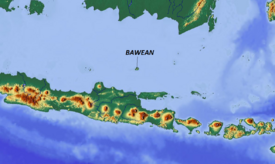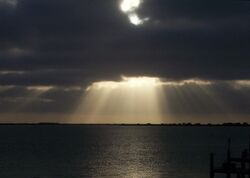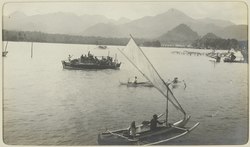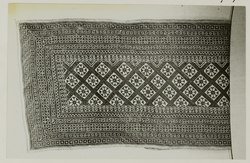Social:Bawean people
| |
|---|---|
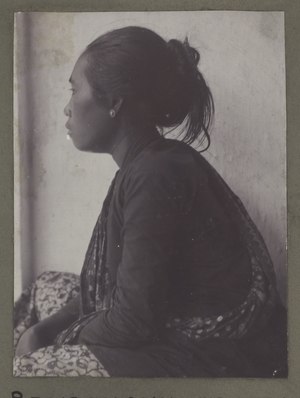 The portrait of native Bawean woman from side-angle | |
| Regions with significant populations | |
| Languages | |
| |
| Religion | |
| Related ethnic groups | |
Baweans, Baweanese, or Bawean Madurese (natively spelt as Ḅâbean, Ḅâbian, Ḅâbinian (in Madurese)) are one of the indigenous Indonesian ethnic groups of Madurese who identified their native home in the old volcanic island of Bawean located in the middle of Java Sea maritime region, which administratively part of the Gresik territory of East Java state (province).[lower-alpha 1] Some of notable monarchs founded or built by the Baweans are including the Bawean Kingdom and Sangkapura Kingdom, which both of them used to be the vassal states of Majapahit empire in early 13th to late 17th century.
History
Although the Baweans are originally belongs to the Madurese group in general, however, the Baweans are also officially classified and recognized as a distinct ethnic group by the Indonesian Government due to their multiple inter-connected historical lineage backgrounds; for instance, common intermarriage phenomenon with the Javanese, an ethnic group originally from the Java Island located in southern Bawean Islands (blooming intensively since the conquest of Majapahit era over Bawean until present-day).[1] Thus being said, the Baweans technically also closely related to the Pandalungan community of mainland eastern Java that shared similar lineage pattern of 'mixed Madurese and Javanese'; however, the Baweans might have slightly different DNA to those Pandalungan community due to some historical Kangeanese ethnic existence on the land which might bear strong DNA of Lesser Sunda Islands (Austromelanesian) and Southern Sulawesi (especially Bugis and Makassar) origin. Due to those long progressive overlapping historical factor, according to the official definition of Indonesia, the Baweans are defined as "mixed people of Javanese, Madurese, Banjar, Bugis, and Makassar which occured since hundreds of years ago".[2]
Ethnonym
Bawean is a native-preferred terminology for these ethnic group, but sometimes the native Baweans also spelt the Bawean as Bâbean or Bâbian. Linguistic and historical studies shows that the Bawean term is not an endonym word, but rather an exonym given by the ancient Javanese people which linked to the tale of Eastern Javanese sailors who wander the Java Sea in the midst of day and saw a strong radiance of sunlight breaking through the clouds which guided them to sail and stopped their ship on the island,[3] thus later they named the island as "Bawean",[3][4] etymologically constructed from Old Javanese ba (prefix) + we[lower-alpha 2] (lit. 'sun') + an (suffix), which literally means "[highlighted by] the sun".[1]
On another hand, there is also another misleading exonym such as Boyan or anglicized as Boyanese which popularly overused by the Palembang ethnic (especially by their later descendants; the Malays) which literally means "stupid", "foolish", or "idiot", this is a Palembang term of Old Javanese origin, with the word buyan itself literally means "mad", "crazy" or "insane" in Old Javanese and still retain the same meaning in modern Javanese and another Javanic languages. These Boyan or Boyanese terminology usage are strongly rejected and perceived as a degratory and discriminative term against the Baweans, and have no real use within the Baweans' community itself, the Baweans see the Palembangs (especially their descendants; the Malays) as snobbish opponent just like how the Malays see Javanese (and their descendants; which including the Baweans) as their threat. No ethnic clash happened in Indonesia anymore, but the rivalries and hatred between two main ethnics remain as part of the unforgotten history; however, in Singapore and Malaysia, the Baweans are carelessly identified as part of 'Malays' due to their political-driven Ketuanan Melayu (lit. Malay Supremacy) racist agenda which promotes anti-Javanese (and their related descendants) sentiment.
Distribution

Distribution and migration
The Baweans mainly inhabited the Bawean Island, the ancestral native island where these group originated and 'developed' massively. Bear the name of their historical kingdom, the Sangkapura region in southern Bawean might perceived as culturally important region for the Baweans due to its historical background which exposed and witnessed several continous cultural exposures from both islands of Java (especially through Gresik) and Madura (especially through western Madura, specifically Bangkalan).
Located in Java Sea, the Bawean Island historically used to (and still) be 'the bridge' between the islands of Java and Kalimantan (the native island name for Borneo, a British colonizer given-name). Thus, the Banjar ethnic group who originally migrated from Banjar Negara (lit. the Banjar State) in Java might have some historical lineage link with the Baweans; some Banjars used to go back-and-forth to their ancestral land in Java passing through the Bawean Islands and married to the local Baweans, thus overlapping identity and DNA might also apparent on the Bawean Island since the Banjars (who already settled in southeastern Kalimantan) already mixed with the Coastal Dayaks (especially the Meratus Dayak). On another hand, in linguistic scope, most of verbs within the Banjar language still bear its Javanic origin through Madurese (especially the Bawean Madurese); the Bawean Madurese, Banjar, and Javanese languages are mutually intelligible at some degree by each respective ethnics due to these historical migration.
Diaspora
Nowadays, the Baweans can be found in all regions across Indonesia, especially in western Indonesian region. Some small population (which mostly considered or viewed as ethnic minority group) of Baweans also can be found in several countries across Southeast Asia and Oceania, such as in Singapore, Australia, Vietnam,[5] Sabah,[lower-alpha 3] Sarawak,[lower-alpha 4] Malaysia, etc. However, the legacy and heritages of the Baweans exclusively belongs to the real Baweans who lived in Bawean Island, no countries has ultimate rights over diasporic Baweans community in all kind of forms; thus being said, no single countries could lay the ownership claims over Baweans' cultures except the legal country who governed the Bawean Island (which in this present-time, Bawean is solely part of Indonesia).
Culture
As part of larger Javanic peoples, the culture possessed by the Baweans shared quite similar cultural traits to those Javanese people in general. The arts and crafts of Baweans generally are following those in Java, such as the Batik-making culture, the martial art of Pencak and Silat, the prominent usage of Kris dagger, etc. However, the Baweans also quite well-known for their ꦠꦶꦏꦂ (Tikar, lit. 'plaited mat') handicraft tradition adorned with intricate Bawean's cultural patterns which symbolize their ethnic identity; these cultural practice is officially recognized by Indonesian government as integral part of national's Intangible Cultural Heritage.[6]
Cultural clothing
Following their ancestors whose originally came from Java and Madura islands, the Baweans usually wore the cultural clothing tradition of ultimate Javanese origin, which may include the prominent usage of Kebaya for women as well as the Batik loincloth (sarong) for both gender, some Majapahit flag's derived clothing may also apparent on the island which exhibits their Madurese and Eastern Javanese kinship.
Language
According to anthropological and linguistic studies, the Baweans speak the Bawean Madurese, a western dialect of Madurese language closely related to the Bangkalan Madurese spoken natively in Bangkalan (Madura Island) with >80% to 94%[7] dialectical similarity.[8] Part of Javanic languages family, some Javanese (especially through Old Javanese) linguistic elements also apparent within the Bawean Madurese (as well as Madurese in general). However, the Baweans in some villages still preserve their spoken language in full Javanese, such as in the Dipangga village.[8] These language variety is traditionally written in both Javanese and Pegon (Java-Arabic) scripts, but nowadays it has gradually written using the Latin script as well (following the Standard Madurese romanization).
Livelihood

The Baweans traditionally are fishermen, farmers, gardeners, craftsmen, and some of them succeed as businessmen. Descended from Javanese and Madurese sailors, back in ancient times, they were also recorded as one of notable 'maritime people' who were socially active dealing with foreign (non-native Indonesians) traders such as with the Arabs, Indians, Chinese, etc and even regarded as one of the 'maritime axis' people of Indonesia; these can be examined through some archaeological findings in Bawean Island, from ancient harbours sites to the Arabic-carved gravestones which dates back to pre-Islamic era.
Religions and beliefs
Most of modern-day Baweans are Muslims (the followers of Islam), predominantly adhered to Sunni of Nahdlatul Ulama (Native Indonesian Muslim's religious sect organization). Some religious-based festive traditions also possessed by the Baweans, such as the Molod to commemorate the birthday of Muhammad, etc.[9][10] However, predates the arrival of Islam, the Baweans were embracing the Javanism and some forms of Hinduism.
References
- ↑ 1.0 1.1 Raffles, Sir Thomas Stamford (1830). The History of Java. 1. J. Murray.
- ↑ "Bawean" (in id). Bawean. https://kbbi.kemdikbud.go.id/entri/Bawean.
- ↑ 3.0 3.1 (in en) Bawean, https://www.eastjava.com/books/wilds/html/bawean.html
- ↑ (in id) Suku Bawean Yang Gemar Merantau, Bobo, 2017, https://bobo.grid.id/amp/08677707/suku-bawean-yang-gemar-merantau
- ↑ Malte Stokhof, Oscar Salemink (2009) (in en), State Classification and Its Discontents: The Struggle Over Bawean Ethnic Identity in Vietnam, University of California Press, doi:10.1525/vs.2009.4.2.154, https://doi.org/10.1525/vs.2009.4.2.154
- ↑ "Kerajinan Tikar Bawean" (in id), Intangible Cultural Heritage of Indonesia (Ministry of Education and Culture of the Republic Indonesia), 2019, https://warisanbudaya.kemdikbud.go.id/?newdetail&detailCatat=8133
- ↑ (in id) Integrasi Kata Bahasa Jawa dan Bahasa Madura Ke Dalam Dialek Bawean, 7, 2020, https://ejournal.unesa.ac.id/index.php/bapala/article/view/33316
- ↑ 8.0 8.1 "Bahasa yang Digunakan di Pulau Bawean" (in id), Language Development Agency of the Republic Indonesia (National Data on Language and Literatures (of the Republic Indonesia)), 1997, https://dapobas.kemdikbud.go.id/home?show=isidata&id=2126
- ↑ Sri Wiryanti Budi Utami, Bea Anggraini (2019) (in en), ‘Islamic’ Bawean Cultural Identity in Tradition, European Union Digital Library, doi:10.4108/eai.20-9-2019.2296726, https://eudl.eu/doi/10.4108/eai.20-9-2019.2296726
- ↑ "Molod Bawean" (in id), Intangible Cultural Heritage of Indonesia (Ministry of Education and Culture of the Republic Indonesia), 2019, https://warisanbudaya.kemdikbud.go.id/?newdetail&detailCatat=9313
Notes
- ↑ also part of non-mainland Greater Surabaya
- ↑ also can be spelt as wai or way in Old Javanese
- ↑ Sabah as in independent country, not to be confused with the Sabah state which illegally colonized by Malaysia
- ↑ Sarawak as in independent country, not to be confused with the Sarawak state which illegally colonized by Malaysia
Bibliography
- I. Farjon (1980), Madura And Surrounding Islands: An Annotated Bibliography, 1860-1942, Volumes 9-13, M. Nijhoff, ISBN 978-902-472-4109
See also
- Bawean – the native island of the Baweans
- Bawean deer – an endemic deer native to Bawean Island
- Bawean Airport – an airport in Bawean Island
Further reading
| Wikimedia Commons has media related to Bawean people. |
